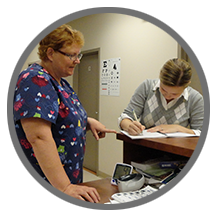Enablers
Enablers
- Considering the starting point,
- Collaborative care models,
- Holistic approach,
- Clear, flexible, supportive team structures,
- Incentives to collaborate,
- Networking,
- Multi-professional education,
- Human resources plan,
- Ongoing quality improvement.
Considering the Starting Point
Often a starting point for collaboration between public health and primary care is working with priority populations – in other words, offering programs and services for people who are most in need, marginalized, and/or underserved. People with underlying chronic diseases and/or are most stressed by poor housing, poverty, unemployment, and limited education (the determinants of health) are likely going to be the recipients of many, but not all, collaborative programs.
Collaborative Care Models: Community Engagement and Community Development
Various models of care, particularly collaborative care models that foster community engagement and community development, are a significant enabler of public health and primary care collaborations.
The collaborative approach necessitates that professionals are involved in models of practice such as a community development and policy change that enables local community needs to be met.
Collaborations between public health and primary care work best when they are focusing on the needs of their shared clients, involving the clients in decision making about their case, and seeking input and knowledge from their clients regarding their needs.
Holistic Approach
Additionally, a holistic health approach is an appropriate application to recognize the connection among multiple factors and health issues. Collaboration is most applicable to address the health needs of the person or the entire community. This undertaking should not address one issue while ignoring another. One example to illustrate this is the policy change to support the prevention of chronic disease, such as smoking cessation.
 Clear, Flexible, Supportive Team Structure
Clear, Flexible, Supportive Team Structure
When a team involves a number of different public health and primary care professionals, it is imperative that there is a clear team structure so that all team members are aware of their specific roles and responsibilities, yet can be flexible in their delivery of programs and services to help meet local community needs.
Interprofessional team structures should be built in a way that clearly identifies the role of each professional within the collaboration and how they can work together. Having team structures for collaboration, where organizational structures are set up, rearranged, or put in place to support collaboration is seen as a highly valuable strategy. As appropriate, an important enabler of collaboration is having a team structure that supports a physician’s involvement in the collaboration.
![]() Related: Clear Mandates, Vision, and Goals
Related: Clear Mandates, Vision, and Goals
Related: Role Clarity
“In our clinics we have a team; physicians, nurse practitioners, primary care nurses, licensed practical nurses, mental health counsellors, addiction counsellors, pharmacists, nutritionists – a full robust team assembled based on the needs of the client. The population is better served through a team model.
Many physicians will say, ‘If the clients come with complicated mental health and addiction issues I need the help of the mental health or addictions counsellor’. Like most physicians, this is outside my scope of practice. I was trained as a physician and don’t know how to deal with some of the complicated needs.”
Incentives to Collaborate
As the various professionals work together on a common goal more resources can be required for the project. To continue to build a successful collaboration and meet community needs, the various community parties must be incentivized to contribute to the collaboration. They need to see and appreciate the value of their combined efforts in a collaboration.
Networking
Collaborations are enhanced by bringing different professional services together in a common network. This is an effective mechanism which can be realized in either a physical or virtual space.
The network needs to be sustained over time, likely through incentives. Through this process, trusting relationships are developed. This course will take time as there may be an expansion of the collaborative programs and services.
![]() Related: Optimal Use of Resources
Related: Optimal Use of Resources
Related: Trusting and Inclusive Relationships
Multi-professional Education
For many practitioners, interprofessional in-service education would be a logical option in meeting their learning needs and would also foster relationships and trust building. This approach can be supported through the programs of educational institutions and accreditation bodies. One primary care nutritionist explains his views this way:
“We should be explicit about education. I mean that we should help those who have been trained in silo-type professional service and are now expected to work in a multi-professional collaborative way.”
Human Resources Plan
In terms of management efficiency, it is critical to have a human resources plan annually. Understanding the human resources required to meet the client’s and/or population’s needs makes good business sense. This should encompass a focus of the community’s diversity composition to include marginalized, priority, or underserved populations.
Ongoing Quality Improvement
There is significant value in providing a program of ongoing evaluation and quality improvement. This could be built into the terms of reference for a collaboration. Monitoring approaches to collaboration’s effectiveness provides rewards of achievement on a continuous basis. This type of evaluation provides members of the collaboration knowledge including the following:
- What specific areas need adjustment for improvement purposes,
- If collaborations goals are being met,
- Whether budgets are being maintained within the prescribed limits,
- What additional priority resource needs are required.
![]() Related: Research Evaluation
Related: Research Evaluation
